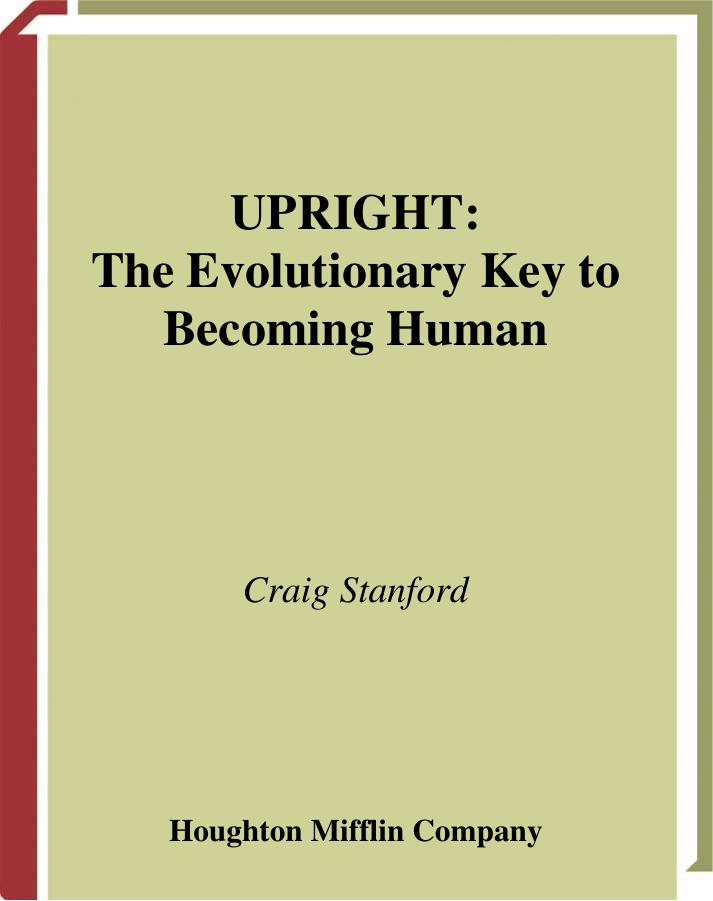UPRIGHT: The Evolutionary Key to Becoming Human by CRAIG STANFORD

Author:CRAIG STANFORD
Language: eng
Format: mobi, pdf
Published: 0101-01-01T00:00:00+00:00
6
WHAT DO YOU STAND FOR ?
THE KALAHARI DESERT OF southwestern Africa is a harsh place to live. The climate is so inhospitably hot and dry that most animals must live underground during the day. When they do come out to forage, they must cope with a variety of predators, from poisonous snakes underfoot to birds of prey overhead. Survival is determined by intense vigilance and some luck. In this environment a small mammal is a savory snack for a wide range of larger creatures.
One such small mammal is the meerkat, a diminutive member of the mongoose clan. Looking like a cross between a tabby cat and a rat (a meerkat had a starring role in The Lion King), these small carnivores live out their daily lives while coping with the risk of death-by-predator every waking hour. Meerkats have evolved a unique strategy for dealing with this threat. When meerkats leave their burrows in the early morning hours to forage, one or more of their group stands sentinel on the raised rim of earth above their subterranean home. But the way they stand has attracted the attention of human evolutionary scholars. Meerkats stand upright while guarding their kith and kin. As though they are auditioning for the Coldstream Guards at Buckingham Palace, meerkats stand on two legs — alone, in pairs, or trios — their backs arched rigidly to maximize their ability to scan their surroundings. The appearance of an eagle elicits alarm calls from the sentinels and a hasty retreat to the burrow by the entire clan.
Meerkats stand only a foot or so tall, but scientists believe that those few extra inches of height that they gain by raising themselves up momentarily give them an edge. Bipedal posture for vigilance is also one speculation about why our ape ancestors decided to stand up. Unlike the meerkat example, in which sentinel behavior has been shown to serve as a survival benefit for kin of the sentinel, human evolutionary experts can only imagine what the benefits of bipedal vigilance would have been for our ancestors five million years ago. So standing up to be vigilant is a theory of human origins, but it is not testable unless we look outside the primate order and see its value in the little meerkat.
When we want to figure out why the earliest humans may have stood up and walked, we usually turn to other animals. But examples from the animal kingdom, including the meerkat, are fraught with problems. Why, for example, would an early hominid need to stand on two legs habitually, when it serves the meerkat well to stand only on occasion? The meerkat story provides a useful, albeit limited, analogy, because it fits a particular story about human origins — that we had a need to see what was happening in the distance.
Theories about human origins are supposed to be rigorously scientific, not fanciful stories. Yet getting anyone in the scientific community to accept your theory is difficult unless it takes the form of a story.
Download
UPRIGHT: The Evolutionary Key to Becoming Human by CRAIG STANFORD.pdf
This site does not store any files on its server. We only index and link to content provided by other sites. Please contact the content providers to delete copyright contents if any and email us, we'll remove relevant links or contents immediately.
Modelling of Convective Heat and Mass Transfer in Rotating Flows by Igor V. Shevchuk(6378)
Weapons of Math Destruction by Cathy O'Neil(6116)
Factfulness: Ten Reasons We're Wrong About the World – and Why Things Are Better Than You Think by Hans Rosling(4675)
Descartes' Error by Antonio Damasio(3209)
A Mind For Numbers: How to Excel at Math and Science (Even If You Flunked Algebra) by Barbara Oakley(3206)
Factfulness_Ten Reasons We're Wrong About the World_and Why Things Are Better Than You Think by Hans Rosling(3185)
TCP IP by Todd Lammle(3118)
Fooled by Randomness: The Hidden Role of Chance in Life and in the Markets by Nassim Nicholas Taleb(3027)
Applied Predictive Modeling by Max Kuhn & Kjell Johnson(3006)
The Tyranny of Metrics by Jerry Z. Muller(2984)
The Book of Numbers by Peter Bentley(2897)
The Great Unknown by Marcus du Sautoy(2632)
Once Upon an Algorithm by Martin Erwig(2585)
Easy Algebra Step-by-Step by Sandra Luna McCune(2560)
Lady Luck by Kristen Ashley(2514)
Practical Guide To Principal Component Methods in R (Multivariate Analysis Book 2) by Alboukadel Kassambara(2485)
Police Exams Prep 2018-2019 by Kaplan Test Prep(2468)
All Things Reconsidered by Bill Thompson III(2345)
Linear Time-Invariant Systems, Behaviors and Modules by Ulrich Oberst & Martin Scheicher & Ingrid Scheicher(2323)
